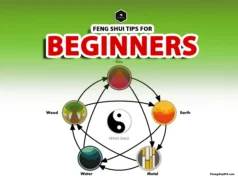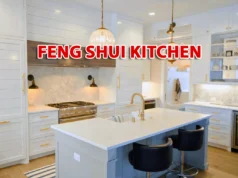A feng shui living room brings balance, comfort, and positive energy into your home. As the heart of your space, it welcomes guests, strengthens family bonds, and channels chi.
In this guide, BTA Feng Shui shares expert tips to arrange your living room for better well-being, stronger relationships, and lasting prosperity.
Why Feng Shui Matters for Your Living Room
The living room is the primary space for social interaction and energy exchange in your home. According to feng shui, it’s where external chi enters and influences the household’s health, wealth, and harmony.
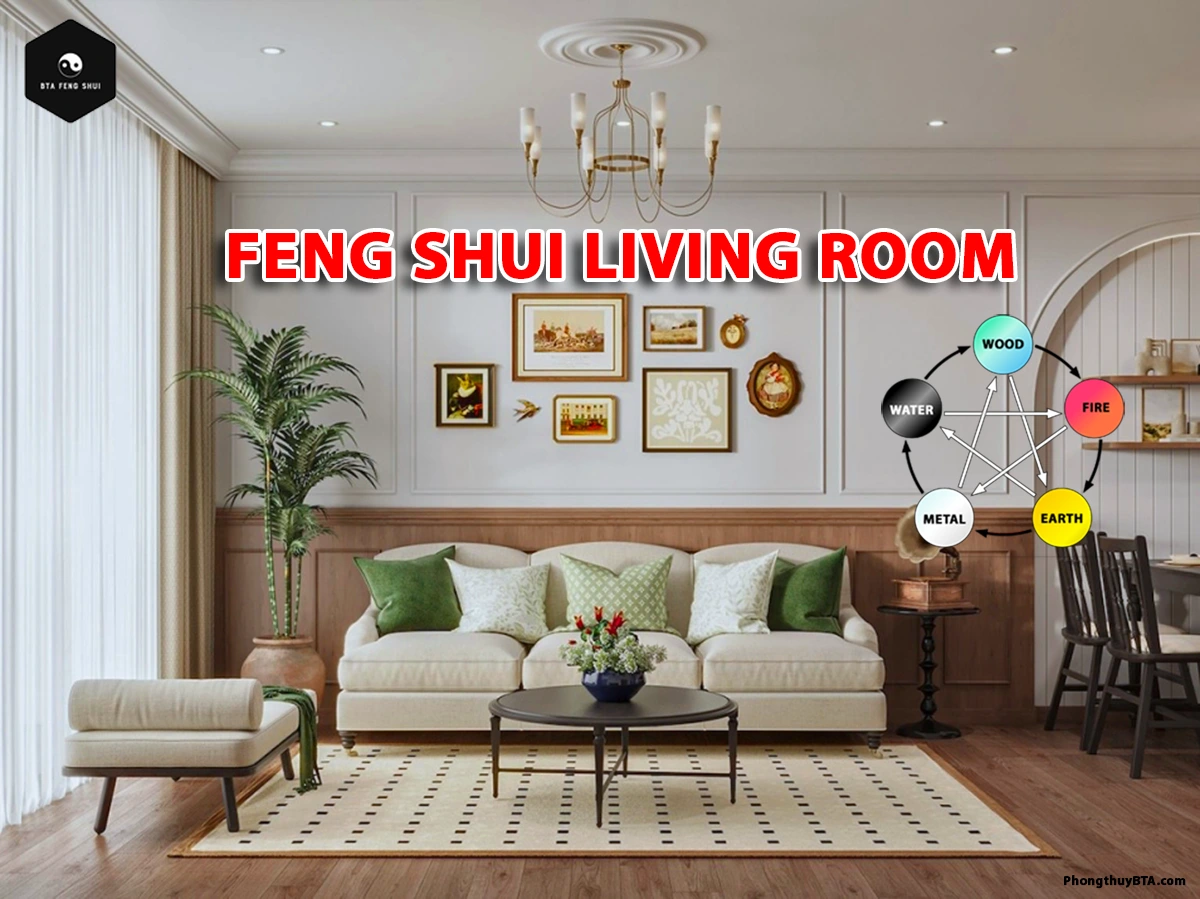
A well-designed feng shui living room promotes relaxation, creativity, and connection, while poor arrangements can lead to stagnant energy, stress, or disharmony. By aligning furniture, colors, and decor with feng shui principles, you create a space that nurtures both your spirit and your home’s energy.
Key Feng Shui Principles for Your Living Room
Follow these expert tips to create a harmonious feng shui living room arrangement that aligns with your home’s energy and personal needs.
1. Position Your Living Room for Optimal Energy Flow
Place your living room near the main entrance to capture incoming chi. This strategic location allows positive energy to flow freely into the home, activating wealth and vitality.

Avoid placing the living room in a back corner, as this can trap energy and create stagnation. Ensure pathways to other rooms remain unobstructed to maintain smooth chi circulation.
2. Choose the Right Direction Based on Your Kua Number
In feng shui, the direction your living room faces influences its energy. Use your Kua number (based on your birth year and gender) to determine auspicious directions. For example:
- East Group Kua (1, 3, 4, 9): Favor East, Southeast, North, or South.
- West Group Kua (2, 5, 6, 7, 8): Favor West, Northwest, Northeast, or Southwest.
Align your sofa or main seating to face your auspicious direction for enhanced luck and comfort. For instance, a person with Kua number 3 (East Group) might orient their sofa toward the East to boost vitality.
Read more:
3. Locate the Money Corner (Tai Wei)
The money corner—also known as the wealth corner or Tai Wei—is a key area for attracting prosperity. To locate it, stand at the main entrance of your living room and find the far-left or far-right corner diagonally opposite the door. Enhance this area with:
- A healthy, vibrant plant (e.g., money plant or jade plant) to symbolize growth.
- A small water feature (e.g., a tabletop fountain) to activate wealth energy.
- Avoid clutter or sharp objects, as they disrupt chi and block financial flow.
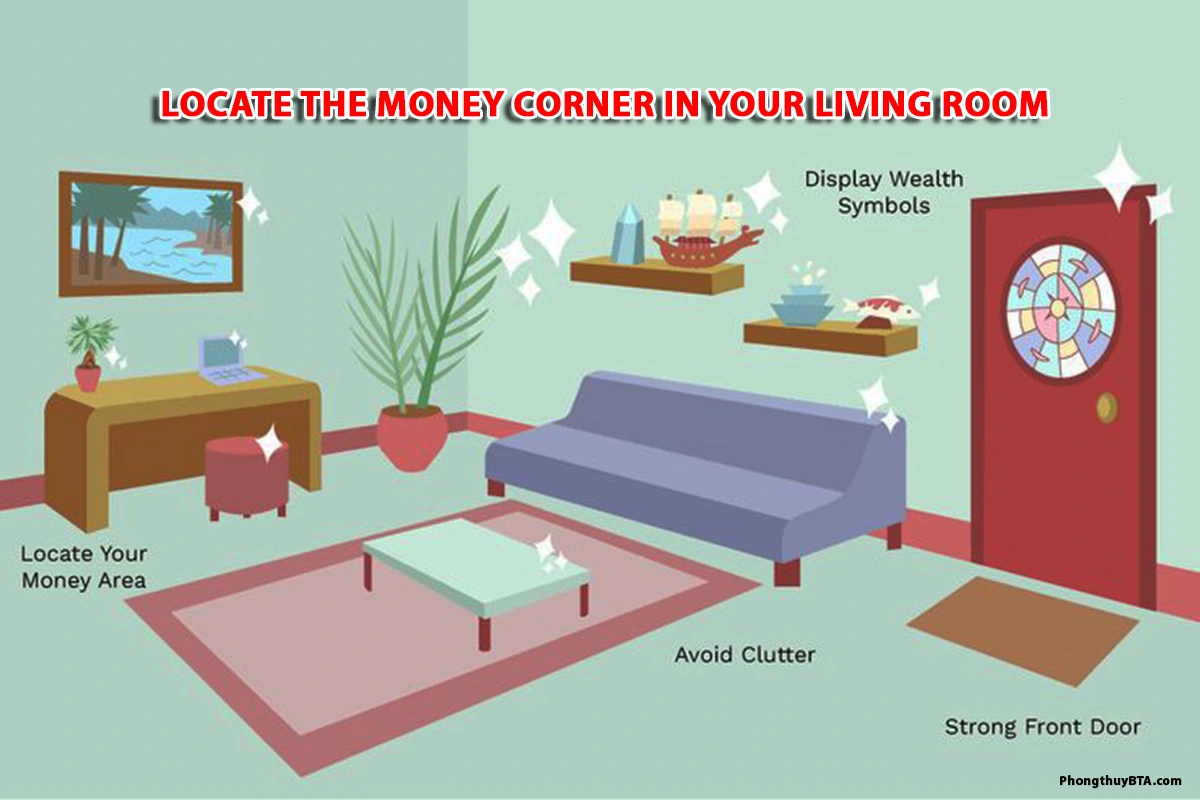
4. Embrace the Five Elements
Incorporate the five feng shui elements—Wood, Fire, Earth, Metal, and Water—to create balance. Each element corresponds to specific colors, shapes, and materials:
- Wood: Green, blue, rectangular shapes (e.g., wooden furniture, plants).
- Fire: Red, orange, triangular shapes (e.g., candles, red cushions).
- Earth: Brown, yellow, square shapes (e.g., ceramic decor, earthy rugs).
- Metal: White, gray, round shapes (e.g., metal frames, white pillows).
- Water: Black, dark blue, wavy shapes (e.g., glass accents, mirrors).
For example, a living room with a wooden coffee table (Wood), red throw pillows (Fire), and a round metal mirror (Metal) achieves elemental harmony. Balance these elements based on your personal element (derived from your birth year) to enhance your energy.
5. Optimize Furniture Placement
A thoughtful feng shui living room furniture layout promotes conversation and comfort. Follow these guidelines:
- Commanding Position: Place the sofa against a solid wall, facing the entrance, to provide security and awareness. Avoid having your back to the door.
- Encourage Connection: Arrange sofas and chairs in a U-shape or circle to foster interaction. Ensure each seat has a clear view of the room.
- Avoid Sharp Edges: Opt for rounded furniture (e.g., circular coffee tables) to soften energy and prevent “cutting chi.”
- Clear Pathways: Keep walkways open to allow chi to flow freely. Avoid blocking doors or windows with furniture.
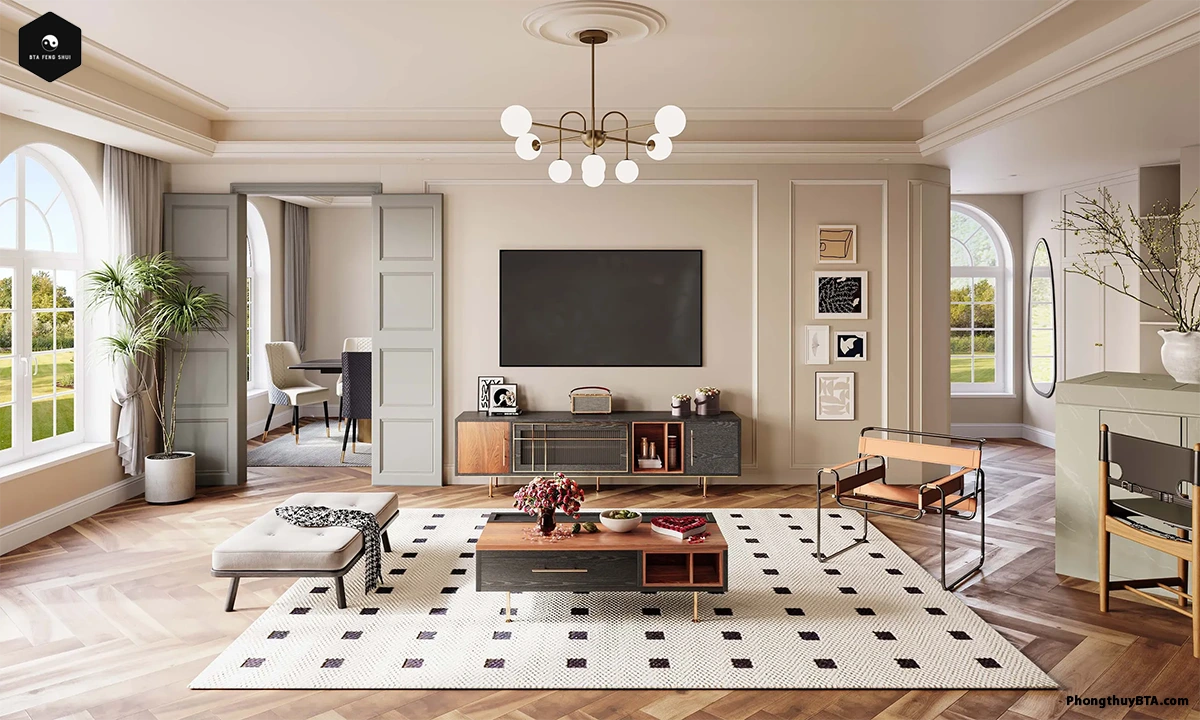
For small spaces, such as an apartment feng shui living room, use multifunctional furniture (e.g., a storage ottoman) to maintain openness without sacrificing utility.
6. Maximize Natural Light
Natural light is a powerful source of yang energy, symbolizing vitality and warmth. Open windows daily for at least nine minutes to refresh chi, and use sheer curtains to soften harsh sunlight. Supplement with layered lighting:
- Ambient: Ceiling fixtures for overall illumination.
- Task: Table lamps for reading or work.
- Accent: Wall sconces or uplights to highlight decor.
Choose warm-toned lighting (2700–3000K) to create a cozy, inviting atmosphere. Avoid dim or overly harsh lighting, which can suppress energy.
7. Use Mirrors Strategically
Mirrors amplify light and energy, making them a potent feng shui tool. Place a round mirror to reflect beautiful views (e.g., a garden or artwork) to double positive energy.
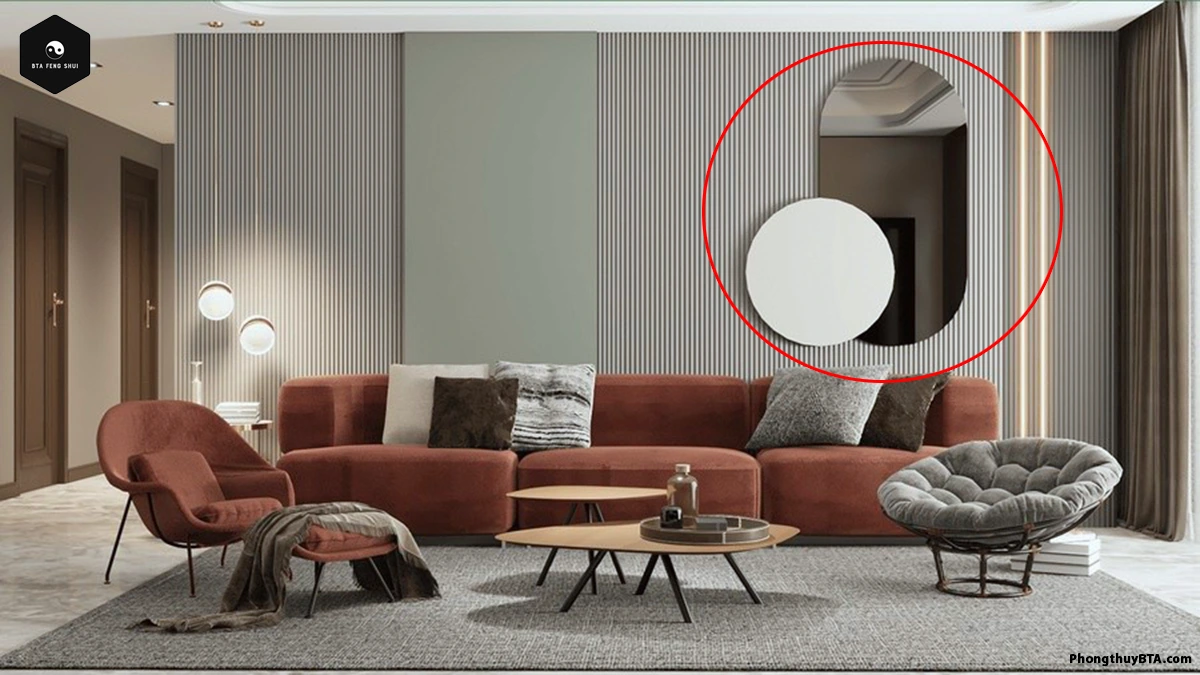
Avoid mirrors directly facing the main door, as they can push chi out of the room. For example, a mirror above a console table reflecting a vibrant plant enhances prosperity and vitality.
8. Incorporate Plants for Vitality
Healthy plants bring Wood element energy, symbolizing growth and renewal. Choose thriving plants like snake plants, peace lilies, pothos plant or orchids, and place them in corners or near windows to invigorate chi.
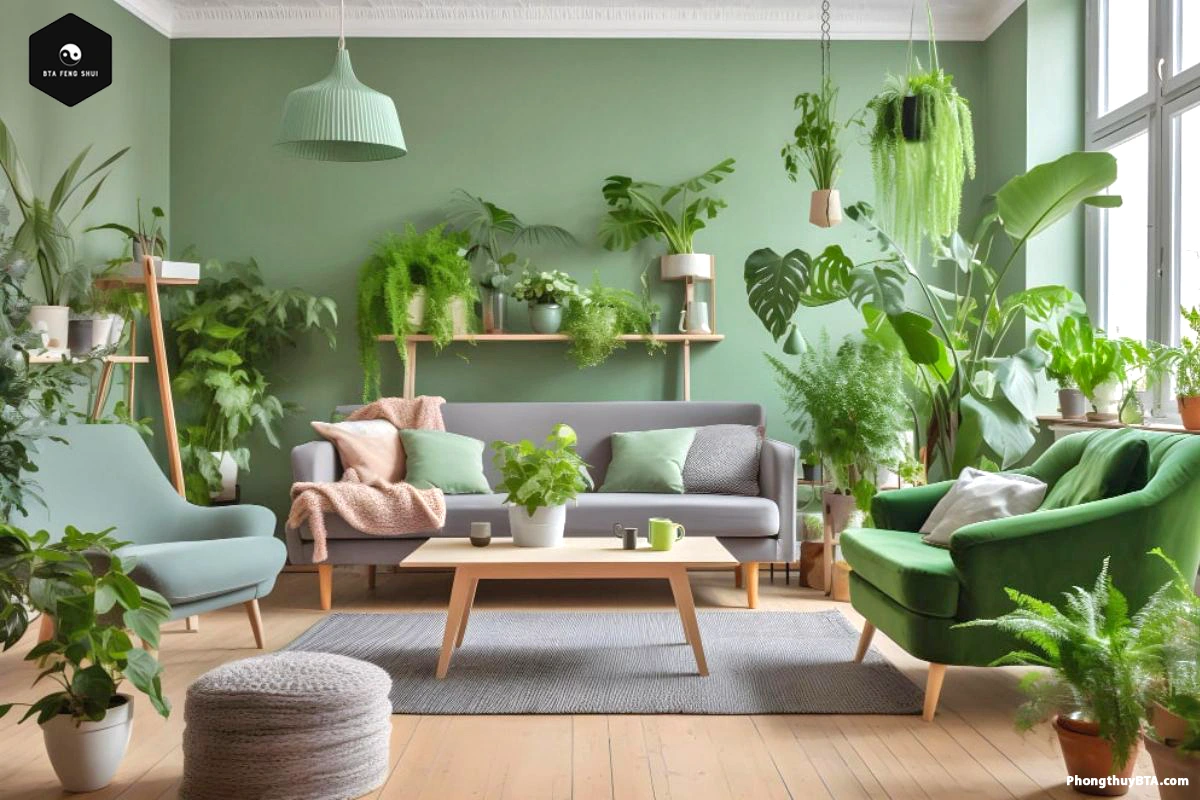
Avoid dead or wilting plants, as they create stagnant energy. For a feng shui for small living room, use vertical planters to save space while adding greenery.
9. Declutter for Clarity
Clutter blocks chi and creates mental overwhelm. Regularly declutter your living room by removing unused items and organizing with stylish storage solutions (e.g., baskets or built-in shelves).
A clean space fosters clarity, productivity, and peace. For example, store electronics in a cabinet to reduce visual chaos and maintain a serene atmosphere.
10. Select Meaningful Colors
Colors influence mood and energy. Choose hues based on your living room’s Bagua area (determined by overlaying the feng shui Bagua map on your floor plan) or your personal element:
- Wealth (Southeast): Purple, green, gold.
- Relationships (Southwest): Pink, red, earthy tones.
- Career (North): Black, dark blue, white.
For a feng shui living room decorating touch, add accent colors through pillows, rugs, or artwork to align with your intentions. Avoid clashing colors that conflict with your element (e.g., avoid red for Water-element individuals).
Read more:
Feng Shui Color Chart: Best Feng Shui Colors and Elements Guide
11. Balance Yin and Yang
Create harmony by balancing yin (soft, passive) and yang (bright, active) energies. For example:
- Yin: Soft textiles (e.g., plush throws, cushions), dim lighting, cozy nooks.
- Yang: Open layouts, bright colors, lively decor.
A reading corner with a soft armchair (yin) paired with an open seating area for socializing (yang) creates a dynamic yet peaceful space.
12. Avoid Common Feng Shui Mistakes
Steer clear of these pitfalls to maintain positive energy:
- Overcrowding: Too many sofas or chairs can disrupt chi and create tension. Stick to one cohesive furniture set.
- Exposed Beams: Ceiling beams above seating areas create oppressive energy. Use false ceilings or decor to soften their impact.
- Sharp Decor: Avoid pointed objects (e.g., swords, angular statues) that generate negative chi.
- Misaligned Doors: A front door facing a back door or window allows chi to escape. Use a screen or plant to slow the energy flow.
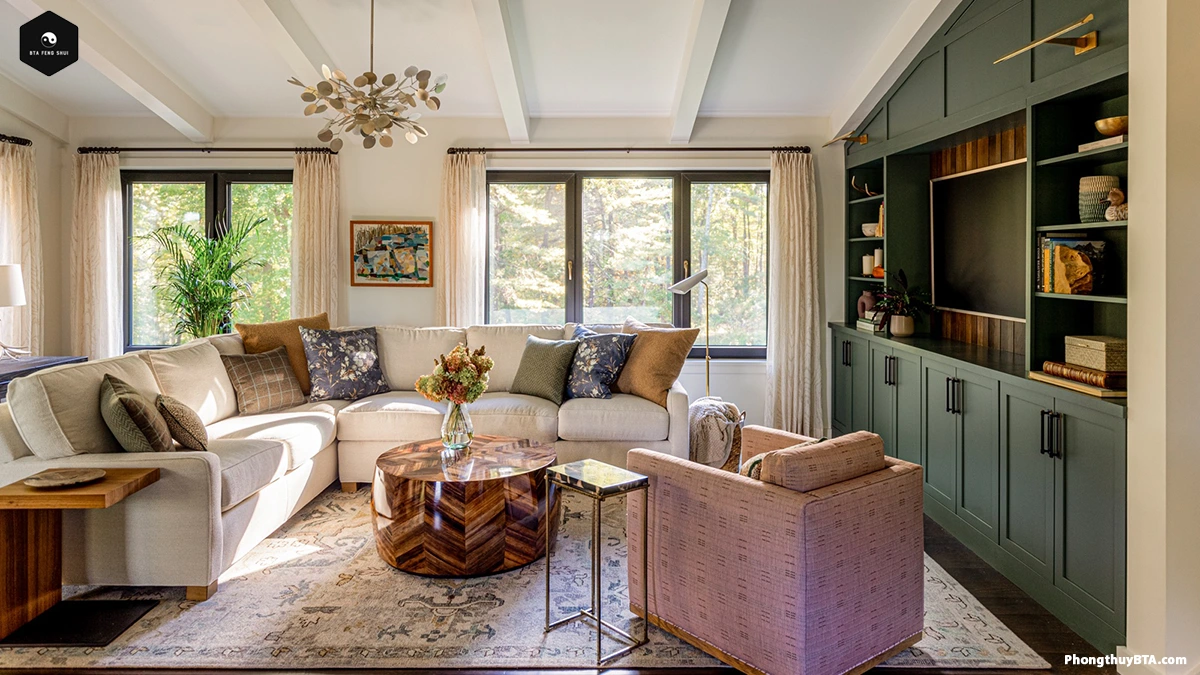
Feng Shui for Specific Living Room Shapes
The shape of your living room affects its energy flow. Tailor your layout accordingly:
- Square: Balance with rounded decor (e.g., circular mirrors) to soften rigidity.
- Rectangular: Place furniture along the longer walls and add a round table to break up linearity.
- L-Shaped: Divide into zones (e.g., seating and reading areas) using rugs or plants to create cohesion.
- U-Shaped: Center a coffee table to anchor the space and ensure open pathways.
See also:
Feng Shui Sofa and TV Placement
- Sofa: Position the feng shui sofa in the commanding position, facing the entrance but not directly in line with it. Ensure it’s backed by a solid wall for support. For example, a sectional sofa angled diagonally can optimize both comfort and energy flow.
- TV: Treat the TV as a Fire element. Place it in a Bagua area you wish to energize (e.g., the Fame area in the South for recognition). Mount it on a wall to reduce clutter, and cover it when not in use to minimize its yang energy.
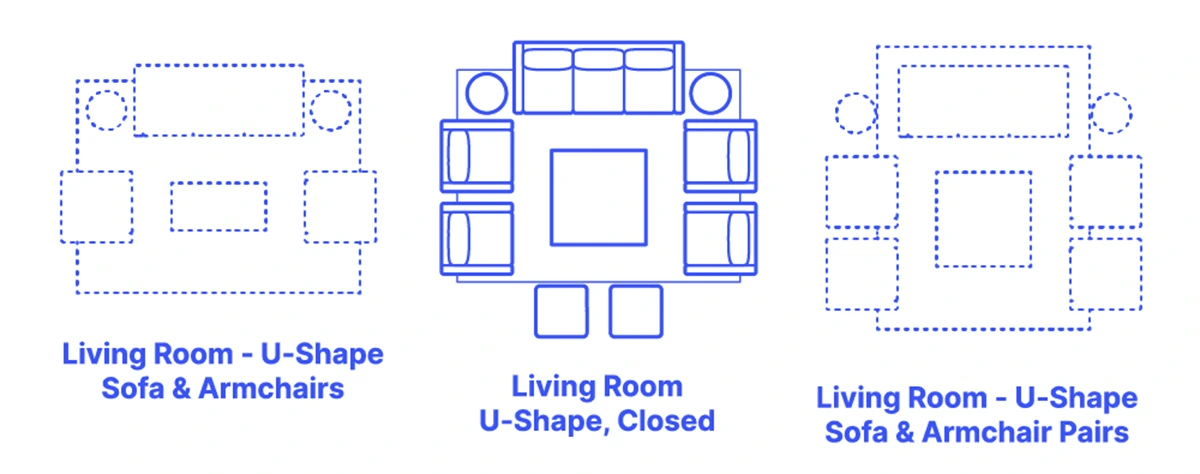
FAQs About Feng Shui Living Room Design
What is the best sofa placement for feng shui?
Place the sofa in the commanding position, facing the entrance with a solid wall behind it. This fosters security and awareness while encouraging conversation.
How do I arrange plants for feng shui?
Position plants in corners or near windows to enhance vitality. Avoid overcrowding or placing them in pathways, as this can block chi. Opt for healthy, rounded-leaf plants like money plants.
What colors are best for a feng shui living room?
Choose colors based on the room’s Bagua area or your personal element. For example, greens and purples suit the Wealth area, while earthy tones enhance Relationships.
Can I use a mirror in my living room?
Yes, but place it to reflect positive elements like light or art. Avoid mirrors facing the door, as they can deflect incoming chi.
A feng shui living room is more than an aesthetic space—it’s a haven that nurtures your well-being and prosperity. By thoughtfully arranging furniture, incorporating the five elements, and avoiding common mistakes, you can create a harmonious environment that supports your goals and relationships. Apply these principles to transform your living room into a vibrant, balanced sanctuary.
Please rate this guide 5 stars and share it to spread the wisdom of feng shui!



